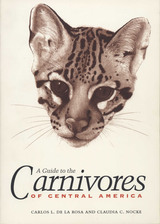
Carnivores such as pumas, jaguars, and ocelots have roamed the neotropical forests of Central America for millennia. Enshrined in the myths of the ancient Maya, they still inspire awe in the region's current inhabitants, as well as in the ecotourists and researchers who come to experience Central America's diverse and increasingly endangered natural environment.
This book is one of the first field guides dedicated to the carnivores of Central America. It describes the four indigenous families—wild cats, raccoons and their relatives, skunks and their relatives, and wild canids—and their individual species that live in the region. The authors introduce each species by recounting a first-person encounter with it, followed by concise explanations of its taxonomy, scientific name, English and Spanish common names, habitat, natural history, and conservation status. Range maps show the animal's past and current distribution, while Claudia Nocke's black-and-white drawings portray it visually.
The concluding chapter looks to the carnivores' future, including threats posed by habitat destruction and other human activities, and describes some current conservation programs. Designed for citizens of and visitors to Central America, as well as specialists, this book offers an excellent introduction to a group of fascinating, threatened, and still imperfectly understood animals.
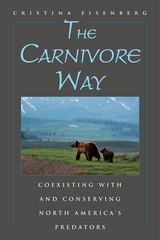
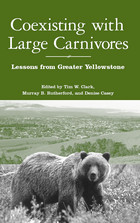
As in the rest of the United States, grizzly bears, wolves, and mountain lions in and around Yellowstone National Park were eliminated or reduced decades ago to very low numbers. In recent years, however, populations have begun to recover, leading to encounters between animals and people and, more significantly, to conflicts among people about what to do with these often controversial neighbors.
Coexisting with Large Carnivores presents a close-up look at the socio-political context of large carnivores and their management in western Wyoming south of Yellowstone National Park, including the southern part of what is commonly recognized as the Greater Yellowstone Ecosystem. The book brings together researchers and others who have studied and worked in the region to help untangle some of the highly charged issues associated with large carnivores, their interactions with humans, and the politics that arise from those interactions.
This volume argues that coexistence will be achieved only by a thorough understanding of the human populations involved, their values, attitudes, beliefs, and the institutions through which carnivores and humans are managed. Coexisting with Large Carnivores offers important insights into this complex, dynamic issue and provides a unique overview of issues and strategies for managers, researchers, government officials, ranchers, and everyone else concerned about the management and conservation of large carnivores and the people who live nearby.
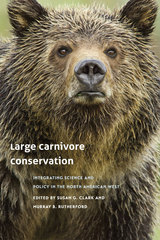
In combining real-world examples with discussions of conservation and policy theory, Large Carnivore Conservation not only explains how traditional management approaches have failed to meet the needs of all parties, but also highlights examples of innovative, successful strategies and provides practical recommendations for improving future conservation efforts.
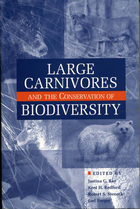
Large Carnivores and the Conservation of Biodiversity brings together more than thirty leading scientists and conservation practitioners to consider a key question in environmental conservation: Is the conservation of large carnivores in ecosystems that evolved with their presence equivalent to the conservation of biological diversity within those systems? Building their discussions from empirical, long-term data sets, contributors including James A. Estes, David S. Maehr, Tim McClanahan, Andrès J. Novaro, John Terborgh, and Rosie Woodroffe explore a variety of issues surrounding the link between predation and biodiversity: What is the evidence for or against the link? Is it stronger in marine systems? What are the implications for conservation strategies?
Large Carnivores and the Conservation of Biodiversity is the first detailed, broad-scale examination of the empirical evidence regarding the role of large carnivores in biodiversity conservation in both marine and terrestrial ecosystems. It contributes to a much more precise and global understanding of when, where, and whether protecting and restoring top predators will directly contribute to the conservation of biodiversity. Everyone concerned with ecology, biodiversity, or large carnivores will find this volume a unique and thought-provoking analysis and synthesis.
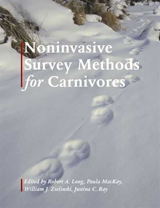
Presented in a straightforward and readable style, Noninvasive Survey Methods for Carnivores is a comprehensive guide for wildlife researchers who seek to conduct carnivore surveys using the most up-to-date scientific approaches. Twenty-five experts from throughout North America discuss strategies for implementing surveys across a broad range of habitats, providing input on survey design, sample collection, DNA and endocrine analyses, and data analysis. Photographs from the field, line drawings, and detailed case studies further illustrate on-the-ground application of the survey methods discussed.
Coupled with cutting-edge laboratory and statistical techniques, which are also described in the book, noninvasive survey methods are effi cient and effective tools for sampling carnivore populations. Noninvasive Survey Methods for Carnivores allows practitioners to carefully evaluate a diversity of detection methods and to develop protocols specific to their survey objectives, study area, and species of interest. It is an essential resource for anyone interested in the study of carnivores, from scientists engaged in primary research to agencies or organizations requiring carnivore detection data to develop management or conservation plans.
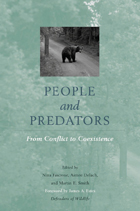
Carnivores provide innumerable ecological benefits and play a unique role in preserving and maintaining ecosystem services and function, but at the same time they can create serious problems for human populations. A key question for conservation biologists and wildlife managers is how to manage the world's carnivore populations to conserve this important natural resource while mitigating harmful impacts on humans.
In People and Predators, leading scientists and researchers offer case studies of human-carnivore conflicts in a variety of landscapes, including rural, urban, and political. The book covers a diverse range of taxa, geographic regions, and conflict scenarios, with each chapter dealing with a specific facet of human-carnivore interactions and offering practical, concrete approaches to resolving the conflict under consideration. Chapters provide background on particular problems and describe how challenges have been met or what research or tools are still needed to resolve the conflicts.
People and Predators will helps readers to better understand issues of carnivore conservation in the 21st century, and provides practical tools for resolving many of the problems that stand between us and a future in which carnivores fulfill their historic ecological roles.
READERS
Browse our collection.
PUBLISHERS
See BiblioVault's publisher services.
STUDENT SERVICES
Files for college accessibility offices.
UChicago Accessibility Resources
home | accessibility | search | about | contact us
BiblioVault ® 2001 - 2024
The University of Chicago Press









